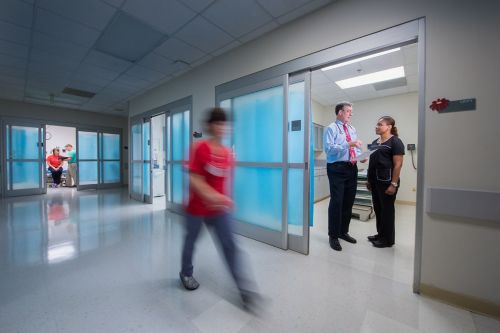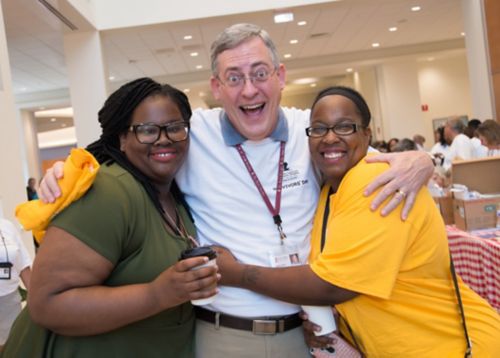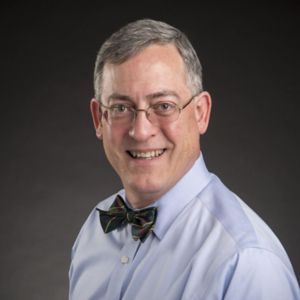St. Jude Family of Websites
Explore our cutting edge research, world-class patient care, career opportunities and more.
St. Jude Children's Research Hospital Home

- Fundraising
St. Jude Family of Websites
Explore our cutting edge research, world-class patient care, career opportunities and more.
St. Jude Children's Research Hospital Home

- Fundraising
Helping childhood cancer survivors thrive

Tim Folse, MD, empowers childhood cancer survivors by teaching them about their health risks and explaining how to share information with their local physicians.
A cancer diagnosis has an immense health impact on a person of any age. An adult with cancer has a body and brain that are already fully formed. But think of all the development ahead of small children with life-threatening diseases. When children receive such a diagnosis, the ramifications may extend 50, 60 or 70 years into the future. Their lives may be knocked off course before they’ve barely begun. They may be pulled out of school, their family lives disrupted. Treatments required to save their lives may also create long-term problems.
Before coming to St. Jude Children’s Research Hospital, I was in private practice. Most of my patients with cancer were older, with 10, 15, 20 or 30 years of life ahead of them. But children with cancer may have even many decades of life ahead of them. That’s why we’re dedicated to preventing long-term problems from disease and its treatment. We want to help cancer survivors understand how to take care of themselves so that they can lead long, productive lives. And we want to use what we learn from them to help the next generation of cancer patients.
Community physicians are well acquainted with screening guidelines for adult-onset diseases. Exams often include blood pressure and cholesterol tests, pap smears, mammograms, colonoscopies and other routine screenings, but a child who had a high dose of an anthracycline at a young age has a cardiomyopathy risk that may be 40 or 50 times higher than a person in the average population. Perhaps a child had high doses of chemotherapy or radiation to the brain. Now, you’ve got a list as long as your arm of potential problems. As a result, screening guidelines for those survivors are vastly different than they would be for older people. Unfortunately, most medical students receive very little training on this topic.
Each year, St. Jude honors patients and families during Survivors' Day. Many of Tim Folse's St. Jude LIFE participants attend, learn about survivorship and talk with other survivors. Throughout the day, Folse greeted survivors and their guests.

Each year, St. Jude honors patients and families during Survivors’ Day. Many of Tim Folse’s St. Jude LIFE participants attend, learn about survivorship and talk with other survivors. Throughout the day, Folse greeted survivors and their guests.
It’s crucial to supply survivors with a comprehensive care plan that includes specifics on the treatment they received, particular problems that might result from the disease or its treatment, and detailed screening recommendations.
At St. Jude, I have the privilege of empowering cancer survivors by teaching them about their risks and explaining how to share that information with their local physicians. Because childhood cancer is so rare, our staff fields calls every day from patients and physicians. We try to offer them the best possible advice and assistance. We also have medical students, oncology fellows, graduate students and trainees from around the world come through St. Jude to receive training about cancer survivorship.
In 1994, our division director, Melissa M. Hudson, MD, of Oncology, realized the need to categorize all the data being amassed from the After Completion of Therapy (ACT) Clinic. She recruited a team of researchers to help her study the late effects of childhood cancer treatments. Now, we’re following about 1,200 children, adolescents and young adults in the ACT Clinic, plus close to 4,000 adult survivors in the St. Jude Lifetime Cohort Study, also called St. Jude LIFE. Those efforts are generating data that will help us make recommendations for the treatment and follow-up of future childhood cancer survivors. The information will also help us develop interventions to promote healthful lifestyles.
It’s my job to help provide that data for our researchers so they can continue to use and share it with survivors.
Nickhill Bhakta, MD, of Global Pediatric Medicine at St. Jude, recently looked at the chronic problems our patients have—not only whether they have certain problems, but the severity of those issues. We’re also able to compare groups of patients by when they received treatment. Our ongoing work with St. Jude LIFE shows those being treated in recent years are experiencing fewer and less severe late effects.
Overall, most of our survivors are doing well and are carrying on with their lives. Many of those who are compromised have found ways to adapt. For instance, they may have attention or memory issues, so they’ll tell me, “Well, I keep a lot of lists.”
I’m constantly inspired by the resiliency of our survivors. Part of that is the St. Jude spirit—the way they have been encouraged through the years. Families who came here in the 1960s and ’70s and ’80s have told me, “We knew that if we could just get to the front door of St. Jude, then everything would be OK.” And now they enthusiastically participate in our cancer survivor studies.
When I thank them, they often respond, “Are you kidding? I’d do anything for St. Jude.”






